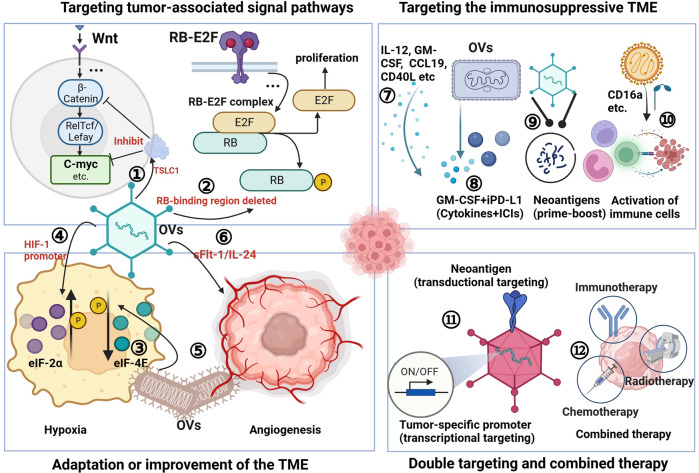Fig. 2.
Mechanism for targeting and oncolysis of OVs. Oncolytic viruses (OVs) target dysfunctional signaling pathways. (1) Targeting the Wnt signaling pathway, recombinant adenovirus express lung cancer suppressor-1 (TSLC1), acts by downregulating the transcriptional activity of Tcf4/β catenin and inhibiting the expression of CyclinD1 and C-myc, thereby killing Wnt abnormally activated liver cancer cells. (2) E1A(922-947) deleted AdVs replicate and lyse tumor cells. OVs targeting for the adaptation or improvement of the tumor microenvironment (TME) of the tumor. (3) VSV replicates under hypoxic conditions with increased phosphorylated subunits of eIF-2α and inhibits the translation of host cell proteins through the dephosphorylation of translation initiation factor eIF-4E. (4) The Hypoxia inducible factors (HIFs) promoter was applied in AdV to the delivery target genes under hypoxia. (5) VSV naturally targets vascular endothelial cells and inhibits the growth of tumor cells. (6) Expression of vascular growth factor inhibitors (sFlt-1) and anti-angiogenic cytokine (IL-24) by OVs to inhibit tumor angiogenesis. OVs Targeting immunosuppressive TME. (7) OVs were designed to express a variety of cytokines, chemotactic factors, immune checkpoint inhibitors (ICIs) and neoantigens. (8) OVs simultaneously expressing cytokines (GM-CSF) and ICIs (iPD-L1). (9) Neoantigens encoding OVs and heterologous prime-boost strategy (AdV+MVA) (10) Activation of immune cells for tumor lysis by OVs. (11) Combine tumor-specific promoter-derived transcriptional targeting with transductional targeting (through viral capsid incorporation of anti-human carcinoembryonic antigen single variable domains). (12) Combined OV therapy with chemotherapy, radiotherapy and other immunotherapies, etc. (Created in BioRender)

